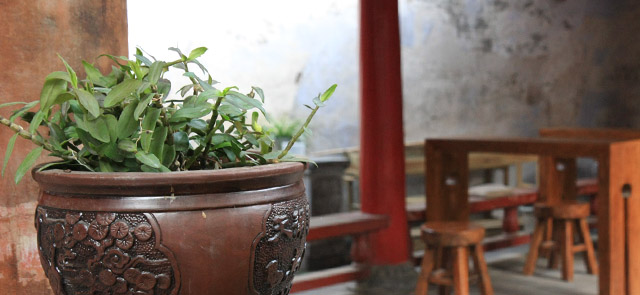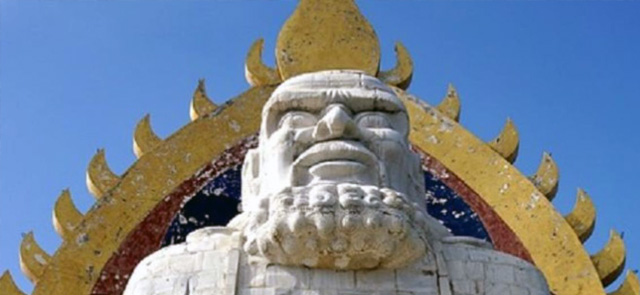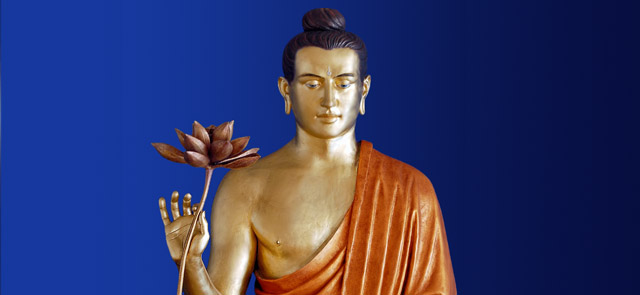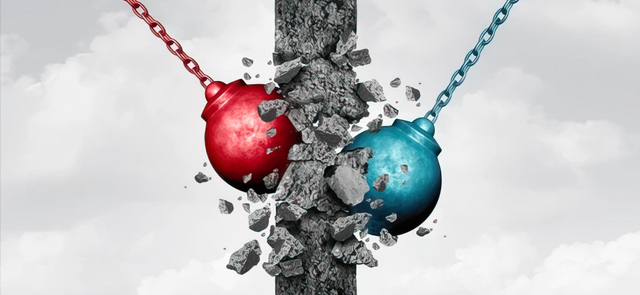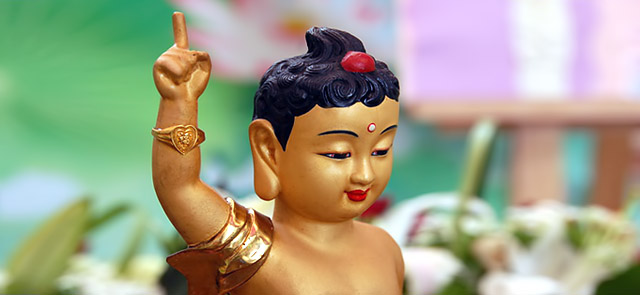Shakyamuni Buddha [Chin.: Shì jiā móu ní fó 释迦牟尼佛 ] taught about a Buddha named Amitabha [Chin.: Āmítuófó 阿弥陀佛 | Sansk.: अमिताभ Amitābha], the Buddha of "of Immeasurable Life and Light" also known as Amitayus, the Buddha of "Boundless Life", who presides over a Buddha-realm known as Sukhavati, a realm of rebirth in which all impediments to the attainment of final Enlightenment are nonexistent.
What exactly is a "Pure Land?"This realm, or Pure Land [Chin.: Jìngtǔ 淨土], or else known as the Realm of Bliss, is the result of the accumulated merit of the Bodhisattva Dharmakara -"Dharma Storehouse" [Chin.:Fǎzāng bǐqiū 法蔵比丘| Sansk.: Dharmakara], who practiced for eons before becoming the Buddha Amitabha. Dharmakara vowed that when he attained Buddhahood, the realm over which he would preside would include the finest features of all the other Buddha-realms. These other realms were revealed to Dharmakara by his teacher, the Buddha Lokesvararaja [Chin.: Shìráo Wáng 世饒王 | Sansk.: Lokeśvara (लोकेश्वर)].
It is our own Essential Enlightened Nature.
Master Shi Yan Zhuo [Chin.: shì yán zhuō 释延卓? | 1965 - ?]
Pure Land Buddhism is described as the Path of Serene Trust. This term is broadly interpreted as “faith” and means that one has serene trust and confidence in the power and wisdom of Buddhas, or that one has the firm conviction that the Bodhisattva Vow made by all Buddhas, namely, to lead all sentient beings to Enlightenment, has been or will be fulfilled.
Praising a Buddha’s virtues and keeping a Buddha in mind at all times has been practiced since the earliest days of Buddhism. Indeed, the act of taking refuge in the Buddha means to put one’s trust in the Buddha as an honored teacher. In the Pratyutpanna Sutra [Chin.: Bozhōu Sānmèi Jīng 般舟三昧經 | Sanskr.: Pratyutpanna Samādhi Sūtra], an early Buddhist text, Shakyamuni Buddha talks about the practice of Pratyutpanna Samadhi in which the Buddhas of the ten directions are seen as clearly as the stars at night. Also called the prolonged samadhi, because of the length of time required, either seven or ninety days.
The object of Pure Land Buddhism is rebirth into the Realm of Bliss. This may be seen as literal rebirth into the Buddha-realm called Sukhavati or Paradise [Chin.: Jílè 極樂 or Xītiān 西天| Sansk.:Sukhāvatī] - the Paradise, to which Amit?bha is the guide and welcomer ] and/or as experiencing the direct realization of the realm of the Purified Mind, in which a person becomes one with the limitless Compassion and Wisdom which are the prime characteristics of Buddha Amitabha.
The Tripod
Pure Land Buddhism rests on what is known as the Tripod:
Practice - Single-minded effort aimed at Buddha Remembrance - Buddhānusmṛti, in Sanskrit, which means, “To stay mindful of the Buddha,” and has been a central practice of Pure Land Buddhism since its beginnings. Nian-Fo also refers to the recitation of the Buddha’s name, among other practices.
Aspiration - The Vow to be reborn into the Pure Land through realizing the Pure Land which is one's True Mind.
Faith - Also known as "Serene Trust" in one's True Nature, which also means having that same trust and confidence in the Compassion and Wisdom of Amitabha Buddha and all Buddhas. This includes the firm conviction that the Bodhisattva Vow made by all Buddhas to lead all sentient beings to Enlightenment either has been or will be fulfilled.
The Pure Land tripod of Faith, Aspiration and Practice was modified in 12th century Japan. The 18th vow of Dharmakara was interpreted to mean that one only need to recite Amitabha’s name to attain rebirth. The teacher Shinran further narrowed this interpretation to say that the Nembutsu (Japanese for Nian-Fo) is recited until the Mind of Faith manifests itself, and that faith in Amida Buddha (the Japanese term for Amitabha) is sufficient for rebirth. The Japanese Pure Land schools are still characterized as “faith-only” schools, while classical Pure Land Buddhism still relies on the tripod of Faith, Aspiration and Practice as expedients.

